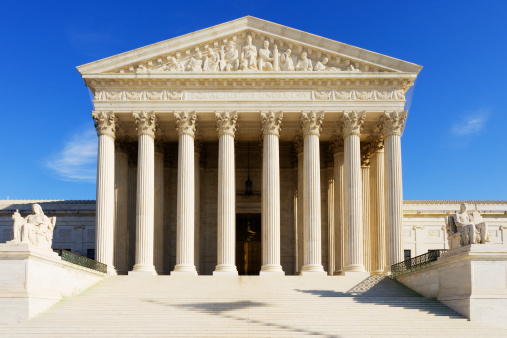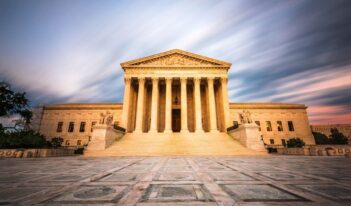
The Supreme Court lets the president down easy in NLRB v. Noel Canning.
As losses go, NLRB v. Noel Canning is going to be pretty easy for the National Labor Relations Board (NLRB) and future presidents to live with.
In a 5-to-4 vote, the U.S. Supreme Court held that Article II’s Recess Appointments Clause empowers presidents to fill vacancies that occur at any time and during any recess—intra-session or intersession—of sufficient length. The Court did invalidate President Obama’s January, 2012, recess appointments of three NLRB members, but only on a narrow two-part rationale. First, a series of pro forma Senate sessions held between December 17, 2011, and January 23, 2012, were effective in dividing this 37-day break into periods of adjournment no longer than three days. Second, periods of intra-session adjournment shorter than 10 days are “presumptively” too short to count as recesses that trigger the president’s recess appointments power. (There is some ambiguity in the majority opinion whether the 10-day rule now applies even to intersession adjournments, which, as far as I know, no party ever argued.) Because of the pro forma sessions – which the D.C. Circuit had not addressed at all – the NLRB owes the Noel Canning Co. a do-over in its unfair labor practice proceeding.
All in all, it was a good day for the legacy of Chief Justice John Marshall. The majority eschewed implausible claims for the supposed clarity of plainly ambiguous constitutional text, in favor of a constitutional reading that was guided by a history of interbranch practice. Marshall would have approved the Court’s framing of the intra- versus inter-session recess problem:
The question is not: Did the Founders at the time think about intra-session recesses? Perhaps they did not. The question is: Did the Founders intend to restrict the scope of the Clause to the form of congressional recess then prevalent, or did they intend a broader scope permitting the Clause to apply, where appropriate, to somewhat changed circumstances? The Founders knew they were writing a document designed to apply to ever-changing circumstances over centuries. After all, a Constitution is “intended to endure for ages to come,” and must adapt itself to a future that can only be “seen dimly,” if at all …We therefore think the Framers likely did intend the Clause to apply to a new circumstance that so clearly falls within its essential purposes, where doing so is consistent with the Clause’s language.
In short, pragmatism trumped an overconfident textualism.
This result ought to elicit from the NLRB a double sigh of relief. First, there were pending before the Court two other recess appointment cases involving decisions rendered, in part, by former NLRB member Craig Becker, who was, like the 2012 trio, appointed during an intra-session recess and to a pre-recess vacancy. The recess in question, however, was two weeks long – and thus a recess of sufficient length to properly trigger the President’s appointments power. The NLRB now effectively wins those cases, and all decisions rendered with Mr. Becker’s participation are now safe from constitutional challenge.
Second, the do-over in Noel Canning’s case should not be a heavy lift. The NLRB can exercise its authority under the Administrative Procedure Act to take “official notice” of the record already compiled in its earlier adjudication. The D.C. Circuit has held that, based on that record, the NLRB’s determination that Noel Canning acted unlawfully was not “arbitrary and capricious,” but based on “substantial evidence.” In other words, the Board would have been upheld but for the recess appointments issue. In fairness, of course, the NLRB will owe Noel Canning (and its own General Counsel) the opportunity to supplement the earlier record. It seems highly unlikely, however, that arguments now available to Noel Canning but not made at its original hearing will change the outcome of the case. Barring some otherwise altered circumstances, Noel Canning will ultimately be required to execute a collective bargaining agreement with its union.
Although the Supreme Court held that President Obama’s NLRB recess appointments were invalid, Noel Canning is nevertheless mostly good news for presidents. It should be observed, however, that the dispute took on a certain Emily Litella quality (“Never mind!”) once the Democratic Senate majority ended the filibuster for executive agency appointments. President Obama was already the least frequent user of recess appointments authority among recent presidents and would surely not have bothered with the NLRB appointments if he could have secured regular appointments with only 51 votes in the Senate. (As it is, President Obama made the 2012 NLRB appointments, as well as the appointment of Richard Cordray to direct the Consumer Finance Protection Bureau, only because the vacancies in those positions threatened to plunge those agencies into dormancy.)
As for the future, of course, presidents may have to worry, at least a little, if their party controls neither house of Congress. If the Senate is controlled by the President’s party, the no-filibuster rule is likely to eliminate the need for recess appointments all but entirely. Should the opposition party in either the House or Senate try to prevent the Senate for adjourning for more than three days at a time, the other house – if controlled by the president’s party – could demand adjournment on a set date. Should the two houses formally disagree, the president would then be positioned to exercise his constitutional authority to adjourn Congress unilaterally and thus create a recess. The Noel Canning majority makes this point explicitly.
If the opposition party controls both houses of Congress, that could pose problems, of course. The president could not count on a Senate majority and there would be no disagreement between the houses regarding when to adjourn – hence, no unilateral presidential adjournment power. Those problems are somewhat mitigated, however, by the statutes that govern executive branch vacancies. The so-called Vacancies Act usually allows the president to fill vacancies in advice-and-consent positions with temporary “acting” administrators. It does not apply to multimember agencies, such as the NLRB. But, for at least some such bodies – such as the Federal Election Commission – Congress authorizes officers to serve beyond their terms until the confirmation of their successors. In short, if the president’s party is entirely in the minority at the other end of Pennsylvania Avenue, an impasse over the NLRB could occur at some future date, but certainly not soon. And few other agencies face similar threats.
Finally, it is worth remembering that even a Senate controlled by the opposition party has an incentive in most cases to cooperate with presidential appointments. Acting agency heads wield less clout than confirmed appointees, but they also have less allegiance to the Senate. The Senate may well prefer to have appointees in place who have created personal and professional relationships with relevant committees and who have pledged on the record to be accountable to the Senate.
In sum, the Supreme Court’s Noel Canning decision upholds the D.C. Circuit’s outcome, but (wisely, in my view) repudiates its reasoning and leaves the elected branches with pretty much the same tools already available to them to foster either friction or cooperation. All in all, it’s a good day for constitutionalism.




